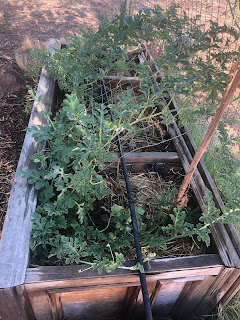Core Gardening, Conserving Water in a Desert Garden by Mandi Leigh
Growing a vegetable garden in the Arizona desert is a daunting task because it's hot, and water is scarce. With dry temperatures well above 100°, maintaining soil moisture is a constant concern. And there is the desert gardener's conundrum: a desire to conserve water coupled with the necessity to hydrate plants regularly. What better place to turn for gardening advice than to those in the Sahara Desert? The Sahara Desert in Africa is know as the hottest and driest desert in the world. Temperatures reach well above 130°, and annual rainfall is around 3 inches. How have people managed to survive in this region of the world? Core gardening.
What is Core Gardening?
Core gardening is a great method used to conserve water while providing a plant with the soil moisture and nutrients that it needs. The core garden is constructed in 3 layers. A trench is lined with water absorbing materials such as grass clippings, vegetation, straw, wood or paper. A layer of nutrients is added including compost, kitchen scraps, manure, or other fertilizers. Finally, a layer of topsoil is added. Plants or seeds are placed directly into the topsoil layer. When the garden is watered, the water absorbing layer (grass, paper, straw, etc) will soak up and retain the water for long periods of time. In turn, the plant roots will chase the moist layer and stay hydrated through longer periods without watering. I decided to put the core gardening method to the test in a small area of my desert garden.Setting Up the Core Garden Experiment
I have multiple raised garden beds, all on an irrigated drip system. In order to complete this experiment, I knew I needed to select an area that would not receive a regular drip, so I selected an area along the back fence. This area receives at least 6-8 hours of direct sunlight, but it is in the partial shade of a mesquite tree. I dug a 15-foot long trench that was approximately 1-foot wide by 1-foot deep. Before beginning the layering process, I lined the trench with 1/4 inch hardwire cloth to deter gophers as much as possible.
Water Retention Layer
I used multiple items around the homestead to construct the water retention layer. First, I lined the bottom of the ditch with papers I had lying around slated for shredding. Next, I placed bundles of small dry sticks less than 1-inch in diameter to keep the papers from blowing away. I added dry straw that I also had on hand. I like to keep dry straw around to add to compost, or use as an emergency mulch.Nutrient Layer
After the water retention layer was in place, the nutrient layer was placed, I dropped just a small line of chicken manure along the length of the trench. Next I covered the trench with about 1 to 2 inches of compost. I spread a handful of fertilizer granules on top of the compost.Topsoil Layer
The topsoil layer mainly consisted of the native soil that was backfilled from the original trench that was dug. A little bit of planters mix from my favorite distributor was mixed in as well. I then directly planted seeds into the topsoil. Watermelon, pumpkin, yellow squash, and butternut squash.






Comments
Post a Comment